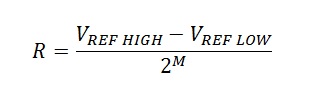
18th December 2014 by Pambos Palas
Analogue to Digital Conversion [PART 4 – Resolution]
Another very important concept of Analog to Digital Conversion (ADC) is that of Resolution. In part 2, Sampling Frequency was discussed, and its effect on the accuracy of the conversion was covered. This was important as the resulting digital signal in a conversion varies discretely with time (at intervals defined by the sampling frequency). Similarly, resolution is important when considering accuracy, as it defines how well the signal’s amplitude is quantized – the digital signal also varies discreetly in amplitude.
In the case of resolution, when an analogue signal is sampled at a certain time, the voltage that is measured is quantified and given a number that represents it. Since the analogue signal can vary infinitely, there is no limit as to how accurate this number can be. Of course, with a more accurate number (i.e. with more significant figures) a better representation will be made – however, more memory is required to make this possible. The resolution of the ADC basically defines the accuracy of the number representing the measured sample.
In practice, when a sample is taken and a conversion is made, the quantized number actually describes where the amplitude lies within two reference levels. As such, the resolution can be defined as the number of discreet values or steps that exist within the reference levels.
For example, if we are taking measurements from a temperature sensor, and we know that the resulting output will realistically be between 0-5V, then it would make sense for the reference levels to be 0V and 5V. If the resolution only allowed for 5 steps, then the measured value would be rounded down to the nearest 1 volt and the representation would be quite poor. If the resolution was doubled, then 10 possible steps would mean that the measure voltage would be rounded down to the nearest 0.5 Volts, and it would be more accurate.
Since the resulting values from a conversion are usually stored in binary form, resolution is commonly expressed in bits. For example, if the resolution is quoted at 8-bits, then there are 2^8 possible steps between the reference levels that an analogue signal can be encoded to. In our example above, if 8-bit resolution was possible, then the measured voltage would be rounded with much higher accuracy. Specifically it can be worked out with the following equation:
Where R is the voltage between each step, also known as the Least Significant Bit (LSB) voltage, and M is the resolution in bits.
Therefore, in our example, the LSB voltage would be (5-0)/256 = 0.0195 Volts. This means that with every additional 0.0195 Volts, the output code would increment. If the measured voltage was 2.3493, for example, then it would be rounded to 2.3400V and the encoded value would be 120 (decimal) or 01111000 in binary.





